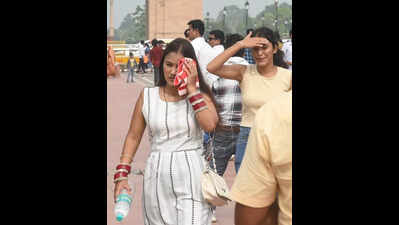New Delhi: A new study by Greenpeace India has revealed a clear link between rising heat stress levels beyond the summer months and a surge in unrecognised human deaths, particularly among Delhi’s homeless and vulnerable sections.Using the Universal Thermal Climate Index (UTCI), the study showed that between 2019 and 2024, the mean UTCI values remained above 31.5 degrees Celsius. From 2022 to 2024, Delhi saw 11,819 unidentified deaths, coinciding with the extreme values, the study said. The study, titled Death and Degree: Establishing a Relationship of Death and Heat in Scorched Delhi, explained that “unlike traditional temperature readings, which only reflect air temperature, UTCI accounts for multiple environmental factors, including humidity, water vapour pressure, wind speed, and solar radiation. By combining these variables, UTCI provides a more accurate indication of heat stress than temperature alone.” The report found that the monsoon months are no longer relief months. “Between 2015 and 2024, the traditional rainy season (June–Sept) recorded persistently high UTCI values: 33.6 degrees Celsius in June, 32.4 degrees Celsius in July, and 31.9 degrees Celsius in Aug. High humidity has turned these months into periods of intense heat stress, as sweating… becomes less effective,” the study said.Even July and Aug now feel like peak summer. The mean values remained above 31.5 degrees Celsius, peaking at 34.4 degrees Celsius in July 2019, levels that were previously associated with peak summer. However, sharp increase in heat stress also occurred between March and April, with the UTCI jumping by 6.13 degrees Celsius (a 30.78% increase), marking the onset of extreme summer stress.The upward trend in UTCI aligned with the unidentified deaths in the city. The study drew on the monthly number of unidentified bodies recovered, many of homeless people. This data was compiled by the Centre for Holistic Development (CHD).According to the study, in 2019, 5,341 such deaths were recorded, aligning with the record UTCI levels. In June 2019 alone, 657 deaths were recorded at a peak UTCI of 34.2 degrees Celsius. However, in June 2024, 192 homeless people died within just nine days (June 11-19), the highest death toll in two decades, said the study.Selomi Garnaik of Greenpeace India said: “Our analysis shows that Delhi’s heat crisis is extending well beyond summer into the monsoon, creating a prolonged season of danger. The data shows a clear and undeniable link between rising thermal stress and thousands of preventable deaths.” Garnaik added that unless urgent measures are taken to recognise heat as a disaster and safeguard at-risk communities, Delhi will continue to lose lives in silence.Manoranjan Ghosh, assistant professor at Symbiosis International University, Pune, and one of the authors of the study, said: “Since there is no specific sophisticated ‘diagnostic test’ for heatstroke, certifying deaths directly linked to heat remains a clinical challenge, yet the time-specific pattern of mortality reveals an undeniable relationship. The prolonged exposure to scorching conditions has proven especially lethal, with the homeless being the worst affected.“The report urged measures to address Delhi’s escalating heat crisis. It called for the inclusion of homeless populations and outdoor workers in heat action plans through the establishment of cooling shelters, hydration stations and medical outreach programmes.The study stressed the need for legally recognising heatwaves as disasters under the Disaster Management Act, 2005, which would unlock relief funds, strengthen preparedness and ensure accountability for preventable deaths.











